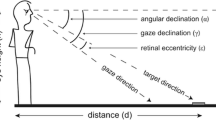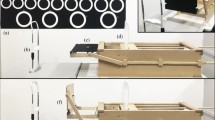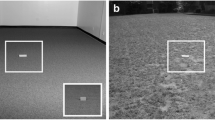Summary
The effectiveness of the relative size cue to distance as a function of directional separation was investigated with the successive presentation of two luminous frames of the same shape but different visual angle. Either 0° or 180° of separation occurred between the successive presentations. In Exp. I the frames at 5 feet were viewed monocularly through a restrictive aperture. In Exp. II, the same frames were viewed monocularly through a lens such that the frames were at an accommodative distance of 100 feet. Reports of both the size and distance of the frames were obtained in each of the experiments. The results were analyzed in terms of the absolute size cue to distance occurring on the first presentations as well as the relative size cue to distance occurring between presentations. There was a tendency (not always statistically significant) to report the smaller frame at a farther distance than the larger frame, but only in Exp. II is there evidence that this tendency was greater on second than on first presentations. Therefore in Exp. II the relative size cue to distance was demonstrated to occur independently of the absolute size cue and it occurred at least as readily for the 180° as for the 0° separation between successive presentations. In both experiments the results from the size reports provide evidence for the presence of the relative size cue between successive presentations for both the 180° and 0° separations. It is concluded that the relative size cue is as effective when O must turn 180° to view the successive stimuli as when the successive stimuli are presented along the same line of sight. The procedure that is sometimes used of employing large directional separations in an attempt to avoid the relative size cue is, therefore, considered to be inappropriate. The results of the study were discussed in relation to a distinction between cognitive and perceptual processes in judgments of size and distance. Both the data of the present study and other results in the literature such as the size-distance paradox were analyzed in terms of a schema in which perceptual processes provided a basis for the rapid utilization of cognitive information.
Similar content being viewed by others
References
Baird, J. C.: Retinal and assumed size cues as determinants of size and perceived distance. J. exp. Psychol. 66, 155–162 (1963).
Carlson, W. R.: Overestimation in size-constancy judgments. Amer. J. Psychol. 73, 199–213 (1960).
Coltheart, M.: (1) The influence of haptic size information upon visual judgments of absolute distance. Perc. and Psychophys. 5, 143–144 (1969).
—: (2) Effects of two kinds of distance information on visual judgments of absolute size. Nature (Lond.) 221, 383 (1969).
—: The effect of verbal size information upon visual judgments of absolute distance. Perc. and Psychophys. 9, 222–223 (1971).
Epstein, W.: Attitudes of judgment and the size-distance invariance hypothesis. J. exp. Psychol. 66, 78–83 (1963).
Gogel, W. C.: Size cue to visually perceived distance. Psychol. Bull. 62, 217–235 (1964).
—: (1) The absolute and relative size cue to distance. Amer. J. Psychol. 82, 228–234 (1969).
—: (2) The effect of object familiarity on the perception of size and distance. Quart. J. exp. Psychol. 21, 239–247 (1969).
—: (3) The sensing of retinal size. Vision Res. 9, 1079–1094 (1969).
- The adjacency principle and three-dimensional visual illusion. Chapter in Psychon. Monog. Suppl., No. 13 (Whole No. 45), Chapter 4 in Human Space Perception, Proceedings of the Dartmouth Conference, J. Baird, Ed. 1970.
—: (1) The validity of the size-distance invariance hypothesis with cue reduction. Perc. and Psychophys. 9, 92–94 (1971).
- (2) Scalar perceptions with binocular cues of distance. (1971) Amer. J. Psychol., in press.
—, Mertens, H. W.: Perceived size and distance of familiar objects. Perc. and Mot. Skills 25, 213–225 (1966).
—, Newton, R. E.: Perception of off-sized objects. Perc. and Psychophys. 5, 7–9 (1968).
Landauer, A. A., Epstein, W.: Does retinal size have a unique correlate in perceived size ? Perc. and Psychophys. 6, 273–275 (1969).
Rock, I., Ebenholtz, S.: The relational determination of perceived size. Psychol. Rev. 66, 287–401 (1959).
—, Kaufman, L.: The moon illusion, II. Science 136, 1023–1031 (1962).
—, McDermott, W.: The perception of visual angle. Acta psychol. (Amst.) 22, 119–134 (1964).
Schober, H.: Über die Akkomodations Ruhelage. Optik 11, 282–290 (1954).
Author information
Authors and Affiliations
Additional information
This investigation was supported by PHS Research Grant No. NS 08883, from the National Institute of Neurological Diseases and Strokes.
Rights and permissions
About this article
Cite this article
Gogel, W.C., Sturm, R.D. Directional separation and the size cue to distance. Psychol. Forsch. 35, 57–80 (1971). https://doi.org/10.1007/BF00424475
Received:
Issue Date:
DOI: https://doi.org/10.1007/BF00424475




